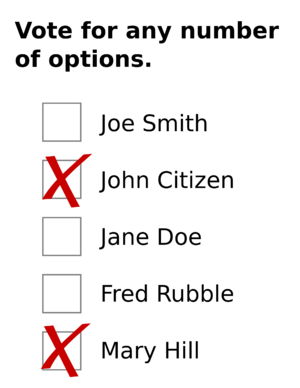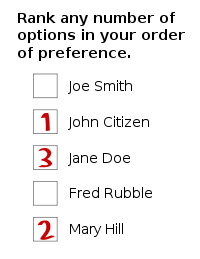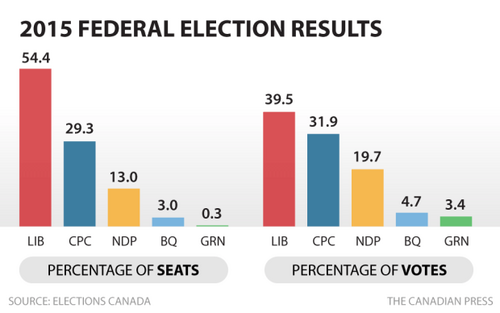Voting Reform
Background
Concern around Canada's first-past-the-post electoral system stem largely from highly disproportionate election results, in which the balance of power in the House of Commons does not reflect the popular vote. As part of the 2015 Canadian Federal Election, Justin Trudeau and the Liberal Party of Canada promised that if elected "2015 would be the last federal election conducted under the first-past-the-post voting system" and that legislation to enact voting reform would be introduced within 18 months of coming to office. [1] After winning election in October 2015, the Liberals set to work to establish a special committee on the topic of electoral reform.
Special Committee on Electoral Reform
On June 7, 2016 The Special Committee on Electoral Reform was formed by the House of Commons to "to identify and conduct a study of viable alternate voting systems to replace the first-past-the-post system, as well as to examine mandatory voting and online voting". [2] The committee includes a Liberal Party President, 2 Vice Presidents from the Conservative Party and New Democratic Party as well as 9 members [3]. 4 of the committee members are from the Liberal Party, 2 are from the Conservative Party, 1 is from the New Democratic Party, 1 is from the Green Party and 1 is from the Bloc Québécois to reflect the power balance in the House of Commons. [4] The committee is to present a final report to the House of Commons with their recommendations no later than December 1, 2016. [5]
Historical Context
Canada has historically had a first-past-the-post voting system. Voting reform in Canada in the late 19th and early 20th century centred around extending voting rights to minorities, such as non-property owners and women who did not previously have the right to vote. [6] Municipalities in Western Canada, as well as Alberta and Manitoba, introduced proportional voting systems in the early 20th century, due to the efforts of various progressive parties, however they were largely replaced with first-past-the-post in the mid-20th century. [7] Significant electoral reform was mostly ignored as a major issue in the later half of the 20th century, however it began to gain steam in Quebec in the 1980s as the Parti Quebecois emphasized the more democratic nature of proportional representation as compared to first-past-the-post. [8] Royal Commissions established by both Pierre Trudeau in 1982, and Brian Mulroney in 1989 advised against any electoral reform at the national level for fears that reform would be impractical and that proportional representation would provide a less stable federal government. [9] Provinces have engaged in several efforts to look into their electoral systems over the past several years, most notably the BC Citizen's Assembly on Electoral Reform which recommended British Columbia adopt a system of proportional representation.[10] However BC Citizens rejected the proposal via referendum. Public opinion at the federal level began to largely reject first-past-the-post after the highly disproportionate election results of the 2011 Federal Election in which the Conservative Party won a majority government after obtaining just only 39% of the popular vote, and the votes of only 24% Canadians. [11]
Proportional Representation
Under a proportional representation system, power in the House of Commons is awarded proportionately based on how many total votes a party receives. [12] For example, if a party receives 35% of the popular vote, that party should receive roughly 35% of the seats in parliament. Proportional representation allows for more representation of minority parties, but does not generate the same kind of stability that the first-past-the-post system due to the fact that it does not often generate majorities in parliament. [13] Proportional representation relies on multi-member constituencies, unlike the single member districts used in first-past-the-post in which each constituency elects one representative. [14] There are several different options for the type of proportional representation used.
Different Voting Systems
Party List System

The party list system is a form of proportional representation in which multiple candidates are elected from a list of available candidates. [15] Parties receive a proportional amount of seats based on the number of votes they receive. There are several different types of party list systems. The two most common are closed and open.
Closed
The most common form of party list is a closed list system in which political parties rank their list of candidates prior to the election. [16] During the election, voters simply vote for a party, rather than a specific candidate and seats are then allocated based on the parties' lists. [17] The closed party list system is very easy for voters to understand and also allows parties to include minorities who are traditionally underrepresented in politics, however there are concerns that it places too much power in the parties themselves who develop party lists based on party politics, rather than the concerns of the electorate. [18]
Open
In open list systems voters choose, not only between parties, but between individual candidates within each party as well. [19] Seats are then allocated by which parties' candidates receive the most votes, and which candidates individually receive the most votes. [20] Proponents of the open list system argue that it gives individual voters more power, however there are concerns about intra-party competition and the fact that it is very for independent candidates to make it onto the list . [21]
Single Transferrable Vote

The single transferable vote system is slightly more complicated, but is the one that was recommended by the BC Citizen's Assembly. The single transferrable voting system relies on multi member constituencies in which multiple candidates are elected. On voting day people rank individuals from a list of available candidates and once a candidate meets a minimum threshold of votes they are considered elected. [22] Voters can then be switched around; if you're preferred candidate has no chance of being elected, or has been elected already, then your vote is transferred to your second preference candidate. [23] The single transferrable vote system ensures that no votes are wasted, and is more likely to result in a proportional outcome as compared to first-past-the-post, however it is very complicated for voters to understand. [24]
References
- ↑ Liberal Party of Canada, 2015 https://www.liberal.ca/realchange/electoral-reform/
- ↑ Parliament of Canada, 2016 http://www.parl.gc.ca/Committees/en/ERRE
- ↑ Parliament of Canada, 2016 http://www.parl.gc.ca/Committees/en/ERRE
- ↑ Parliament of Canada, 2016 http://www.parl.gc.ca/Committees/en/ERRE
- ↑ Parliament of Canada, 2016 http://www.parl.gc.ca/Committees/en/ERRE
- ↑ Law Commission of Canada, 2004 http://publications.gc.ca/collections/Collection/J31-61-2004E.pdf
- ↑ Law Commission of Canada, 2004 http://publications.gc.ca/collections/Collection/J31-61-2004E.pdf
- ↑ Law Commission of Canada, 2004 http://publications.gc.ca/collections/Collection/J31-61-2004E.pdf
- ↑ Law Commission of Canada, 2004 http://publications.gc.ca/collections/Collection/J31-61-2004E.pdf
- ↑ Law Commission of Canada, 2004 http://publications.gc.ca/collections/Collection/J31-61-2004E.pdf
- ↑ 2011 General Election Results, 2011 http://www.electionresources.org/ca/house.php?election=2011
- ↑ Encyclopedia Britannica https://www.britannica.com/topic/proportional-representation
- ↑ Encyclopedia Britannica https://www.britannica.com/topic/proportional-representation
- ↑ Encyclopedia Britannica https://www.britannica.com/topic/proportional-representation
- ↑ Encyclopedia Britannica https://www.britannica.com/topic/proportional-representation
- ↑ Fair Vote http://archive.fairvote.org/factshts/partylst.htm
- ↑ Fair Vote http://archive.fairvote.org/factshts/partylst.htm
- ↑ Fair Vote http://archive.fairvote.org/factshts/partylst.htm
- ↑ Fair Vote http://archive.fairvote.org/factshts/partylst.htm
- ↑ Fair Vote http://archive.fairvote.org/factshts/partylst.htm
- ↑ Fair Vote http://archive.fairvote.org/factshts/partylst.htm
- ↑ Electoral Reform Society http://www.electoral-reform.org.uk/single-transferable-vote
- ↑ Electoral Reform Society http://www.electoral-reform.org.uk/single-transferable-vote
- ↑ Electoral Reform Society http://www.electoral-reform.org.uk/single-transferable-vote
